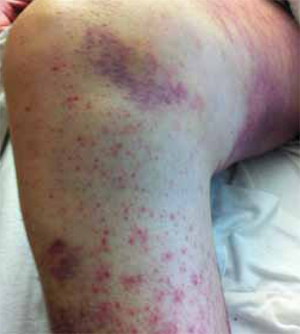Light-headedness and a petechial rash
Were this patient’s complaints of worsening light-headedness, rash, and bruising related to his history of alcohol abuse?
Scurvy: What you’ll see and what the lab work will show
Follicular hyperkeratosis and perifollicular hemorrhagic rash with corkscrew hairs are pathognomonic for scurvy and occur early in the disease. Ecchymosis (FIGURE 2) and splinter hemorrhages are also present.
FIGURE 2
Ecchymosis and petechial rash seen in scurvy
Patients may experience impaired wound healing; abnormal bleeding; muscle, joint, and bone pain; and pathologic fractures.4 There may also be a history of swollen, bleeding gums, tooth loss, and conjunctival varicosities.1,4 Patients may complain of fatigue, exercise intolerance, and depressed mood.
A history of alcoholism is, of course, a red flag. But it’s also important to take note when patients describe a severe food aversion. They may, for instance, tell you that they only eat protein, breads, or other carbohydrates, or that they avoid acidic foods because they have an allergy or because these foods upset their stomach.
Lab work. Serum concentration of ascorbic acid can be checked, although this tends to reflect recent dietary intake rather than actual tissue stores of vitamin C.5 It is estimated that clinical symptoms of scurvy begin to appear when the total body pool of vitamin C has decreased to approximately 300 mg, which reflects a serum level of <0.19 mg/dL.4 Other dietary deficiencies are likely to be present, as well.
There is a leukocyte ascorbate level that more accurately reflects tissue stores of vitamin C, although this test is difficult to perform and not routinely available. (A more practical diagnostic approach is to observe whether clinical abnormalities disappear with repletion therapy.)
Mild anemia is common and its degree correlates with the severity and duration of the scurvy.1 A normocytic-normochromic anemia is usually present and the reticulocyte count is elevated.
Macrocytic anemia may be present due to inadequate folate levels. (Ascorbic acid prevents oxidation of folate to other forms that are excreted in the urine, thus vitamin C deficiency may deplete folate stores by increasing urinary excretion.1)
Iron deficiency anemia is rare in scurvy, even though vitamin C is involved with the absorption of iron.1 Leukopenia is uncommon and platelet counts are usually normal.






